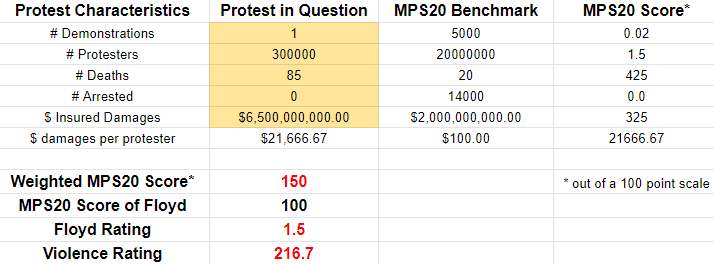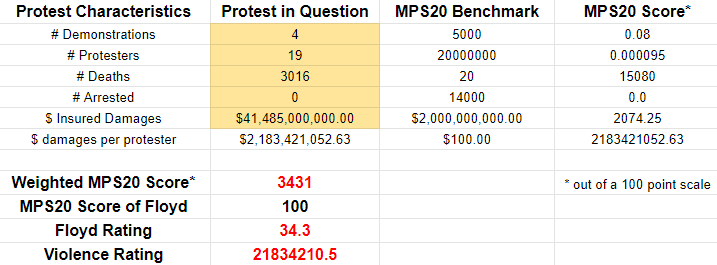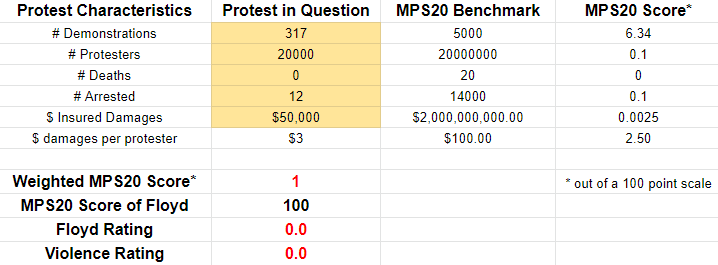A New Unit of Measure for Civil Unrest
The "Mostly Peaceful Summer of 2020" or MPS20 should be our new benchmark.
After the Supreme Court issued Bruen and Dobbs in the span of two days, many social contacts of mine predicted wide scale violence of the nature we saw in 2020 during the Floyd protests. I did not. As they and I discussed the relative scale and nature of the protests over the past weekend, it occurred to us that we need a new unit of measure to mathematically quantify civil unrest and maintain a perspective on it.
I present to you the MPS20, defined as percentage points of the severity of the protests in the summer of 2020 following Floyd, Covid-19, and the Trump reelection. Civil unrest equal to that of the Floyd-Covid protests of 2020 shall rank a 100 on the MPS20 scale, and other instances of civil unrest shall predominantly be expressed as fractions of that 100 point scale.
Features of an MPS20 Level 100 Event
To make mathematical comparisons easy, we will define an MPS20 event by taking round number estimates of features of the Floyd protests.
5000 demonstrations
20 million protesters
20 deaths
14,000 arrested
$2 billion in insured damages
Average of $100 worth of insured damages per protest participant
Sourced from Wikipedia, these numbers in some cases are undercounts because they are only over the central protest window, but since we’re defining a new term here we can use whatever numbers we want. In practice the Floyd protest itself may come in at over 100 on the MPS20 scale if all characteristics of the protest were fully accounted.
Methodology
Asses the statistics of a protest, riot, or insurrection. Divide the number of demonstrations by 5000, multiply by 100 to express as a percent, set this number aside. Divide the total number of protesters by 20 million, multiply by 100 to express as a percent, set this number aside. Divide the number of protest related deaths by 20, multiply by 100 to express as a percent, set this number aside. Divide the number of people arrested by 14,000, multiply by 100 to express as a percent, set this number aside. Divide the total amount of insured damages by $2 billion, multiply by 100 to express as a percent, set this number aside.
The average of these figures gives you a relative perspective on how bad civil unrest is for any given protest event, gauged against Floyd: the MPS20 score. Here’s a calculator:
I also included a “Violence Rating,” which is the ratio of the damages per protestor of the event in question compared to the damages per protestor during the Floyd riots. If the national media wants to make “$100 dollars worth of insurable damage per protester” the benchmark for what counts as “mostly peaceful,” then we can use that as a gauge.
A replica of the Floyd protests will score a 100 on the MPS20 scale, and score a “1” on the violence rating. If we divide a protest’s MPS20 score by 100, that will give us a straight ratio of how bad the civil unrest is compared to Floyd - a “Floyd Rating.” And now we can compare any protest event, or in fact other interesting world events, with the Floyd protest, by using the tool above. Using this tool, you can compare any historical civil unrest against Floyd to see how the level of civil unrest compares. Let’s have some fun with the tool.
Rodney King Riots
The Rodney King riots in 1992 are an interesting comparison point, because while they were smaller in scale they approached the MPS20 benchmark on some metrics while exceeding them on others.
Demonstrations: 1
Protesters: 1 million
Deaths: 63
Arrested: 12,000
Damages: $1 billion
MPS20 Score: 91
Violence Rating: 10
There’s no good way to know how many people protested for Rodney King in 1992. I threw “one million” at the question because that’s about 10% of the Los Angeles population of the time. That one million figure is a vague approximation of the number of black folks in LA in the day, and we might presume that for every black person that didn’t participate, someone of a different race did. By comparison to Floyd, Rodney King had half the damages but ten times the damage per protester and triple the deaths. It was very definitely not “mostly peaceful.” It scores a 91 on the scale. Almost as bad as Floyd, because although it was more localized it was much more violent.
January 6th “Insurrection”
The total count of participants at the January 6th 2021 election protests is not well reported by the media, but HWFO did an analysis on it soon afterwards setting it at a quarter million for the “peaceful” part of the protest. All other necessary numbers have been published. This protest had a Floyd Rating of zero, an MPS20 of 3% of the Floyd protests, and a violence rating of 1.2, landing it squarely in the “mostly peaceful” zone as established by the media for Floyd.
The Troubles in Ireland
Most of the necessary data to utilize the tool on The Troubles is easily available, but I have no good way to measure how much property damage took place during then, so I had to pull a number out of a hat. I also only counted IRA members and affiliates as “protesters.” If you look at Wikipedia’s bombing list, they don’t have values on all of them, and they certainly don’t list all 10,000 attacks either. Throwing 1 million pounds damage per bombing and presuming a 1:1 conversion rate, we end up with about ten billion in damages total and a Floyd Rating of 36.7.
If Hurricanes Were Protests
Calling the number of people impacted or displaced by a hurricane “protesters” we can use the tool to compare against meteorological phenomena.
Hurricane Katrina
If Hurricane Katrina (Category 5, 2005) were a protest, it would be 30 times worse than the Floyd protests and tremendously more violent.
Hurricane Floyd
If Hurricane Floyd (Category 4, 1999) were a protest, it would be about one and a half times worse than the Floyd protests, and 217 times more violent.
Hurricane Sally
If Hurricane Sally (Category 2, 2020) were a protest, it would be about 89% as bad as the Floyd protests, albeit much more violent. A survey of Atlantic and Gulf Coast coast landfalls of historic hurricane events sets the Floyd protests in the ballpark of a typical Category 2 hurricane.
9-11
The September 11th attacks in total came in at 34 Floyds with an incalculable violence rating.
Abortion Protests Last Weekend
Raw statistics on the abortion protests last weekend are very difficult to come by, and the best thing I can find is this CNN article which had some anecdotes and listed some arrests. These numbers are totally made up but should be in the relative ballpark. If every city over 100,000 population had a protest, and average attendance was 500 people, this past weekend rates a 1 out of 100 on the MPS20 scale with a Floyd rating of zero. It was nothing. If you can find better numbers, collate them and plug them into the calculator to see what you get. You may get something different, but not by much.
2020 Richmond Second Amendment Protest
Despite some left wing outlets such as the Philadelphia Inquirer calling it literal terrorism, the Second Amendment Protest in Richmond of 2019 had 22,000 participants, one arrest, no deaths, and cleaned up the streets on their way out. It manages to pull a MPS20 score of zero.
Discussion
Within the test cases we’ve shown here, you can easily see three general thresholds. One tier, which would include the abortion protests over the weekend or the Second Amendment protest in Richmond of 2019, barely registers on the Floyd Scale, with an overall unrest rating of 1% or less of the “Mostly Peaceful Summer of 2020.” (MPS20) The January 6th protest also falls near this range. A second tier, which would include the Rodney King riots and a relatively significant hurricane landfall, registers about the same as the Floyd protests. The third tier, which would include 9-11, The Troubles in Ireland, and Hurricane Katrina, all generally come in at about a Floyd Factor of 30, significantly higher than the MPS20 benchmark. Let’s try to visualize this.
Kamala Harris’s comments comparing January 6th to 9-11 are especially curious in this context, as the Tier 3 event of 9-11 comes in with an MPS20 score one thousand one hundred forty three times worse than the Tier 1 event of 1-6. You can use the tool yourself on other events, to see how they compare:
Conclusion
In our modern media landscape, the outlets do their best to isolate incidents and elevate anecdotes into a sense of data without clearly conveying their scope. They do this to convert fear into click-money, which means we must develop a system to grade the scale of civil unrest events and compare them usefully to other events in the news if we are to remain thoughtful and objective about the world around us.














I kind of think the violence score should be based on the number of deaths and the number of people sent to the ER, not on amount of property damage.
Again, the VCDL Lobby Day was in 2020.